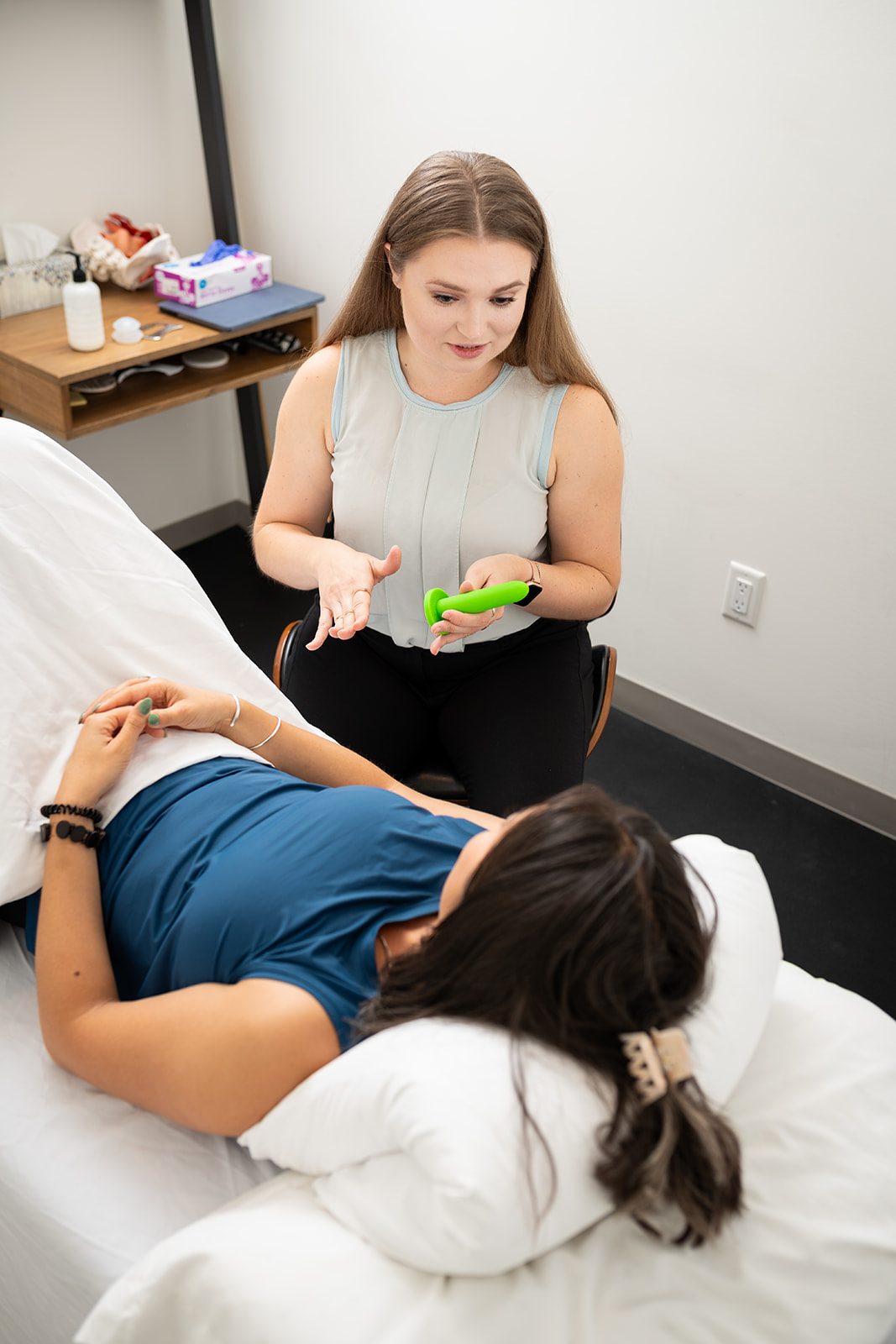Last Updated: 6/30/24
Pregnancy is associated with significant anatomical, hormonal, metabolic, and cardio-pulmonary changes. Isn’t it awesome that our bodies can adapt to these changes and, as a result, create new life?!
Talking more and more to my clients or friends who are pregnant, we have discovered that there is not much out there on how to modify your workouts but continue to stay strong during your pregnancy.
You may want to work out while you are pregnant, especially if you were before. Am I right?
Are you feeling lost and unsure if your prenatal workouts are still right for you? Shoot — with the fatigue, nausea, difficulty eating, and mental exhaustion, to name a few, this can put you on the sideline in your first trimester.
Does this sound like you? Are you unsure how to modify your workouts or what specifically to monitor when you work out? If so, READ ON! (Or book a complimentary discovery call with Pacer Physical Therapy!)
Questions to Ask Before Modifying Workouts During Pregnancy
First, let’s talk about how important it is to advocate for yourself at your 20-week checkup with your doctor. Whether you were able to work out or not in your first few weeks, be prepared to ask your doctor questions about any concerns you have with working out throughout your pregnancy.
Common questions my clients will ask include:
Is it too late to work out in my second or third trimester if I was not feeling well during my first trimester?
The answer is NO, it is not too late. If your doctor did not provide information against working out during your pregnancy, including contraindications or complications involved with your pregnancy, then green light means GO!
But be mindful of slowly getting back into your prenatal fitness level. And build up to your desired ability.
When I work out, I feel like it is very challenging to breathe. Is this normal?
YES. Your major breathing muscle — AKA your diaphragm, which lives in your abdominal cavity under your ribs — is becoming squished by the baby, so it is not able to expand as much as it normally would when you are not pregnant.
THEREFORE, breathing is going to be more difficult. And that is just something you will need to work on more closely.
What do I need to monitor when working out to make modifications in my second and third trimester?
When you are working out during pregnancy, you need to be able to monitor your response to exercise more than ever and monitor how you feel during the workout.
An appropriate warm-up period should be considered to prepare your body before performing a lifting/running/yoga routine and before increasing the intensity. This should take 10-15 minutes and is highly recommended in preparing your body!
Next, you can monitor your heart rate. This can be monitored by taking 220 minus your age to find your maximum heart rate (approximately). Depending on your level of fitness, this can vary, which sometimes makes it hard to rely on heart rate alone as a way to monitor our capacity to workout during a pregnancy.
Next, calculate 55-75% of that number to find an appropriate heart rate zone for you. Again, this is can vary so much based on fitness level that it is tough to monitor alone. So being conscious of this can be a good place to start.
Monitor your intensity by seeing if you can talk during your workout. TALK TEST what what — yes, this is a real thing, and if you do not have a workout buddy, talk out loud and see if you can continue to breathe during the workout. You will know if the exercise intensity is excessive if you are unable to carry out a verbal conversation while working out.
This is my favorite way to monitor exercise capacity during a pregnancy. It’s easy to test and figure out, and you do not need a heart rate monitor or smart watch (which may or may not be accurate).
Lastly, monitor your RPE, the rate of perceived exertion. This scale is a scale that you determine based on how difficult the workout seems to you. It is measured from 6-20 (very light to very hard). Ladies, keep this intensity below or between 12-14 (somewhat hard to hard), which is shown to be appropriate for most women while they are pregnant.
This is not the time to say “I am going to do my MAX 1 repetition deadlift,” unless you have been doing that all along and your body is used to it.
How to Plan a Pregnancy Workout
OK, now you know what to monitor during your workout, so your next question probably is: How do I plan my pregnancy workout!?
Ever heard of the FITT principle? FITT stands for frequency, intensity, time, and type:
- Frequency – The American College of Obstetrics and Gynecology recommends 150 minutes per week of mod intensity exercise with a mix of strength training and cardio.
- Intensity – Check out the above recommendations to see how to monitor the correct intensity for you.
- Time – 15 to 30 minutes per workout, but it could be more as long as your body is feeling good or if you have been doing longer workouts.
- Type – What do you like? Running? Walking? Yoga? Lifting? YOU pick, but just know your body may say, “Hey I am NOT feeling this type of workout anymore.”
Now that you are set up and ready to go, you may notice certain moves are just not working for you. How should you make the adjustments?
What Pregnancy Workout Modifications Should I Consider?
Let’s talk about when you should consider modifications.
By 4-5 months into your pregnancy, lying on your back during workouts should be altered and replaced with lying on your side or standing. This is true for prolonged periods of back-lying exercises and may feel more comfortable in sitting/side-lying or standing position. Listen to how your body feels and do not stay in one position for too long.
Joint laxity is a real thing — AKA joint mobility. Hormones are changing in our bodies, and we need to recognize that (and know that OVERstretching is a real thing).
If anything, I always advise my clients to strengthen during pregnancy. This is SOOO important to keep in mind because this can decrease your chance of lower back or hip pain as you make your way into your third trimester.
Exercises that you should consider modifying as you move into your second trimester include single-leg exercises. Replace them with double-leg to see if they feel more comfortable for your body and more safe.
Consider modifying your core exercises. Yes, you can still get these muscles strong despite the baby pushing them apart.
Every — let me repeat — EVERY woman will have diastasis recti during pregnancy. Diastasis recti is when your abdominal muscles separate to make room for the baby. Monitor bulging, doming, or coning during your workouts, which is when there is an imbalance in your abdominal muscles causing one to push forward and create a “dome-like” appearance.
Manage pressure in your abdominals by thinking about your breathing while you work out. It is important to breathe in as you relax and breathe out as you exert during a workout. If you are running, maintain a normal breathing pattern. This continuous breathing will maintain a normal intra-abdominal pressure (pressure in your abdominal cavity) and allow for balance. And avoid holding your breath when possible during your workout.
Change your environment in which you work out. Especially in your first trimester, avoid humid/warm environments, as they can increase core temperature, resulting in risk of infection.
Lastly, avoid exercise that involves physical contact/danger of falling, as contact sports are more likely to cause a direct trauma or add a risk of falling, which can harm baby and mom.
Other Important Facts:
In one study, regular exercise during pregnancy resulted in around a 40% reduction in the odds of developing complications. WE LOVE THAT! So keep moving and being mindful of your changing body as now you know how to modify your exercises and do the right thing for yourself.
Light-intensity to moderate-intensity physical activity does NOT increase the risk for miscarriage, and may perhaps decrease it. Ladies, if you are nervous or have a concern, ASK your doctor and make sure your doctor is aware of your fitness goals, including continuing to run during pregnancy or training for the CrossFit games!
Wrapping Up: Pregnancy Workout Modifications
All in all, exercise can lower the rate of preterm birth, decrease the risk for induction, shorten the first and second stages of labor, decrease the risk of an unplanned C-section, and decrease the risk of tearing during delivery. I don’t know about YOU, but those reasons are enough for me.
You got this, mom-to-be, now get out there and MOVE.
To find out how to specifically modify your workouts while pregnant, contact us to book a discovery call and obtain a pregnancy workout screen to discuss your fitness goals and discuss workouts that may be right for you.
Resources:
1: Bo Kari, Artel Raul, et al. Exercise and pregnancy in recreational and elite athletes: 2016/2017 evidence summary from the IOC expert group meeting, Lausanne. Part 5. Recommendations for Health Professionals and active women. Br J Sports Med. 2018.
2: PARmed-X for Pregnancy. Physical Activity Readiness Medical Examiner’s. CSEP/SCPE. Canadian Society for Exercise Physiology. 2015.
3: Meah, V, Davies, G, & Davenport M. Why can’t I exercise during pregnancy? Time to revise medical ‘absolute’ and ‘relative’ contraindications: systemic review of evidence of harm and a call to action. Br. J of Sports Med. 2020.





